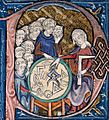Quadrivium facts for kids
The Quadrivium was a special part of education during the Middle Ages. It was like the second big step in a type of learning called the liberal arts. If you completed the Quadrivium, you could earn a Master of Arts degree. It came after another set of studies called the Trivium.
The Quadrivium focused on four main subjects. All of them were connected to mathematics in some way:
- Arithmetic: This was the study of numbers themselves.
- Geometry: This was about shapes, sizes, and how things fit in space.
- Music: This wasn't just playing instruments. It was about the mathematical rules of sound and harmony.
- Astronomy: This was the study of stars, planets, and how they move. It looked at both time and space.
These four subjects were an important part of the learning plan that the ancient Greek thinker Plato wrote about in his book, The Republic.
Contents
What Was the Quadrivium?
The Quadrivium was a key part of learning for many centuries. It helped students understand the world through numbers and patterns. People in the Middle Ages believed that God created the universe using mathematical rules. So, studying these subjects was a way to understand God's creation.
The Four Subjects
Each subject in the Quadrivium taught a different way to look at the world. They were all linked together by the idea of order and harmony.
Arithmetic: The Basics of Numbers
Arithmetic was more than just adding and subtracting. It was about understanding the nature of numbers. Students learned about different types of numbers and how they related to each other. This was seen as the foundation for all other mathematical studies.
Geometry: Understanding Space
Geometry taught students about shapes, lines, and angles. It helped them understand how things are built and how they fit together in the world. This knowledge was useful for everything from building churches to understanding art.
Music: The Science of Sound
In the Quadrivium, music wasn't just about singing or playing instruments. It was about the mathematical relationships between musical notes. Students learned about harmony and rhythm. They studied how different sounds combine to create pleasing music. This was often called "harmonics."
Astronomy: Studying the Cosmos
Astronomy was the study of the stars, planets, and other objects in the sky. Students learned about their movements and how they affected time and seasons. This subject combined ideas from geometry and arithmetic. It helped people understand the larger universe around them.
Education in the Middle Ages
Learning in the Middle Ages was very different from school today. The Quadrivium was taught in universities. These were places where advanced learning happened.
The Language of Learning
All the lessons in the Quadrivium were taught in Latin. This was a very important language at the time. It was the "lingua franca" of medieval Europe. This means it was a common language that educated people from different countries could use to talk to each other. Even the Bible was usually read in Latin. Students had to learn Latin at school or from a private tutor before they could study the Quadrivium.
Who Could Study?
In the Middle Ages, only boys could go to universities. This meant that only males could study the Quadrivium. The teachers were usually priests. If girls wanted to get an education, they had to learn at home. They did not have the same opportunities as boys.
How is it Different Today?
Today, education is much more open. In modern forms of liberal arts education, like those in the United States, both boys and girls can study. While there are still a few schools just for boys or just for girls, most universities welcome everyone.
Images for kids
-
For most medieval scholars, who believed that God created the universe according to geometric and harmonic principles, science – particularly geometry and astronomy – was linked directly to the divine. To seek these principles, therefore, would be to seek God.
-
The Roman philosopher Boethius, author of the The Consolation of Philosophy
See also
 In Spanish: Quadrivium para niños
In Spanish: Quadrivium para niños




